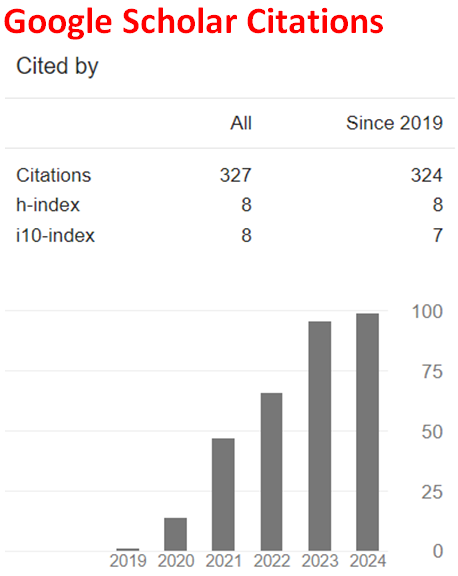Comprehensive Analysis of Nutrient Composition: Evaluating Vitamins, Essential Minerals, and Trace Metals in Neem (Azadirachta indica) Stem Bark Extract
Abstract
The current study sought to investigate the nutrients in an aqueous extract of Neem (Azadirachta indica) stem bark. The bioactive chemical contents of Neem stem bark were isolated, separated, and studied to determine the presence of vitamins, vital minerals, and trace metals. A fresh Neem sample was collected and the sample was ground into powdered form and prepared via extraction using various solvents (n-hexane, ethyl acetate, and ethanol), and the chemical constituents were separated using the GC/MS technique. The Neem stem sample was later digested with nitric acid and hydrogen peroxide in the ratio 4:1 (acid ratio). The trace metals and important minerals in digested Neem samples were determined using an atomic absorption spectrophotometer (AAS), while Na+ and K+ were determined using a flame photometer. The results revealed that calcium is the most prevalent mineral in Neem stem bark, followed by potassium and sodium, but copper, magnesium, iron, zinc, and other minerals are present in trace amounts, while cadmium and lead are virtually missing. Furthermore, according to the results of the vitamin studies, the most abundant vitamins in Neem stem bark are vitamin B3 and vitamin C, but vitamins A, B1, B6, and B12 are present in trace amounts.
References
Martins, E. (2013). The growing use of herbal medicines: Issues relating to adverse reactions and challenges in monitoring safety. Frontiers in Pharmacology, 4, 177. https://doi.org/10.3389/fphar.2013.00177
Fawzi, M. (2013). Traditional medicines in Africa: An appraisal of ten potent African medicinal Plants. Evidence-based Complementary and Alternative Medicine, 2013, Article ID 617459. https://doi.org/10.1155/2013/617459
Islas, J. F., Acosta, E., G-Buentello, Z., Delgado-Gallegos, J., Moreno-Treviño, M., Escalante, B., & Moreno-Cuevas, J. (2020). An overview of Neem (Azadirachta indica) and its potential impact on health. Journal of Functional Foods, 74, 104171. https://doi.org/10.1016/j.jff.2020.104171
Sarkar, L., Oko, L., Gupta, S., Bubak, A., Das, B., Gupta, P., Safiriyu, A., Singhal, C., Neogi, U., Bloom, D., Banerjee, A., Mahalingam, R., Cohrs, R., Koval, M., Shindler, K., Pal, D., Nagel, & M., Sarma, J. (2022). Azadirachta indica A. Juss bark extract and its Nimbin isomers restrict β-coronaviral infection and replication. Virology, 569, 13-28. https://doi.org/10.1016/j.virol.2022.01.002
Rupani, R., & Chavez, A. (2018). Medicinal plants with traditional use: Ethnobotany in the Indian subcontinent. Clinics in Dermatology, 36(3), 306-309. https://doi.org/10.1016/j.clindermatol.2018.03.005
Deng, Y.-X., Cao, M., Shi, D.-X., Yin, Z.-Q., Jia, R.-Y., Xu, J., Wang, C., Lv, C., Liang, X.-X., He, C.-L., Yang, Z.-R., & Zhao, J. (2013). Toxicological evaluation of neem (Azadirachta indica) oil: Acute and subacute toxicity. Environmental Toxicology and Pharmacology, 35(2), 240-246. https://doi.org/10.1016/j.etap.2012.12.015
Patel, S. M., Venkata, K. C., Bhattacharyya, P., Sethi, G., & Bishayee, A. (2016). Potential of neem (Azadirachta indica L.) for prevention and treatment of oncologic diseases. Seminars in Cancer Biology, 40-41, 100-115. https://doi.org/10.1016/j.semcancer.2016.03.002
Batista, F. L. A., Lima, L. M. G., Abrante, I. A., de Araújo, J. I. F., Batista, F. L. A., Abrante, I. A., Magalhães, E. A., de Lima, D. R., Lima, M. D. C. L., do Prado, B. S., Moura, L. F. W. G., Guedes, M. I. F., Ferreira, M. K. A., de Menezes, J. E. S. A., Santos, S. A. A. R., Mendes, F. R. S., Moreira, R. A., Monteiro-Moreira, A. C. O., Campos, A. R., & Magalhães, F. E. A. (2018). Antinociceptive activity of ethanolic extract of Azadirachta indica A. Juss (Neem, Meliaceae) fruit through opioid, glutamatergic and acid-sensitive ion pathways in adult zebrafish (Danio rerio). Biomedicine & Pharmacotherapy, 108, 408-416. https://doi.org/10.1016/j.biopha.2018.08.160
Naik, M., Agrawal, D., Behera, R., Bhattacharya, A., Dehury, S., & Kumar, S. (2014). Study of anti-inflammatory effect of neem seed oil (Azadirachta indica) on infected albino rats. Journal of Health Research and Reviews, 1(3), 66. https://doi.org/10.4103/2394-2010.153880
Roma, A., Ovadje, P., Steckle, M., Nicoletti, L., Saleem, A., Arnason, J., & Pandey, S. (2015). Selective induction of apoptosis by Azadarichta indica leaf extract by targeting oxidative vulnerabilities in human cancer cells. Journal of Pharmacy and Pharmaceutical Sciences, 18(4), 729-746. https://doi.org/10.18433/J3VG76
Dayakar, A., Chandrasekaran, S., Veronica, J., Sundar, S., & Maurya, R. (2015). In vitro and in vivo evaluation of anti-leishmanial and immunomodulatory activity of Neem leaf extract in Leishmania donovani infection. Experimental Parasitology, 153, 45-54. https://doi.org/10.1016/j.exppara.2015.02.011
Kundu, P., Subhasis, B., Sarkar, K., Bose, A., Baral, R., & Laskar, S. (2018). Chemical investigation of NEEM leaf glycoproteins used as immunoprophylactic agent for tumor growth restriction. International Journal of Pharmacy and Pharmaceutical Sciences, 7(2), 195-199.
Dash, S., Dixit, S., & Sahoo, S. (2017). Phytochemical and biochemical characterizations from leaf extracts from Azadirachta indica: An important medicinal plant. Biochemistry & Analytical Biochemistry, 06(02), 2-5. https://doi.org/10.4172/2161-1009.1000323
Raid, A. A., Ayesha, M., Janardhan, K., & Gupta, V. C. (2017). Analysis of anti-bacterial and anti oxidative activity of Azadirachta indica bark using various solvents extracts. Saudi Journal of Biological Sciences, 24(1), 11-14. https://doi.org/10.1016/j.sjbs.2015.08.006
Chavan, Y. R., Thite, S. V., Aparadh, V. T., & Kore, B. A. (2014). Quantification of minerals in some members of family Asteraceae. World Journal of Pharmaceutical Research, 3(6), 613-617.
Uddin, A. H., Khalid, R. S., Alaama, M., Abdualkader, A. M., Kasmuri, A., & Abbas, S. A. (201). Comparative study of three digestion methods for elemental analysis in traditional medicine products using atomic absorption spectrometry. Journal of Analytical Science and Technology, 7(6).
Awotedu, O., Ogunbamowo, P., Emmanuel, I., & Lawal, I. (2018). Phytominerals and phytochemical studies of Azadiracthta indica, Leea guineensis and Parkia biglobosa leaves. International Annals of Science, 6(1), 28-34. https://doi.org/10.21467/ias.6.1.28-34
Garba, S., & Mungadi, H. (2019). Quantitative chemical compositions of neem (Azadirachta indica) leaf aqueous extracts in Sokoto, Nigeria. International Journal of Research and Scientific Innovation (IJRSI), VI(7), 114-119.

This work is licensed under a Creative Commons Attribution 4.0 International License.


